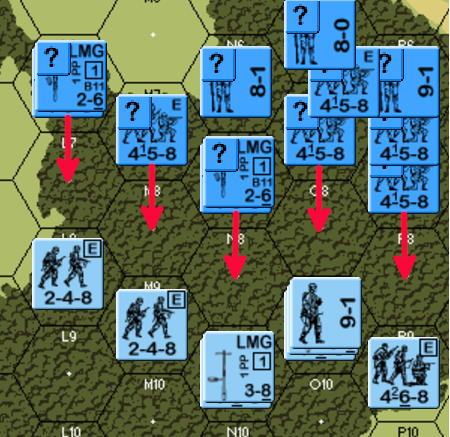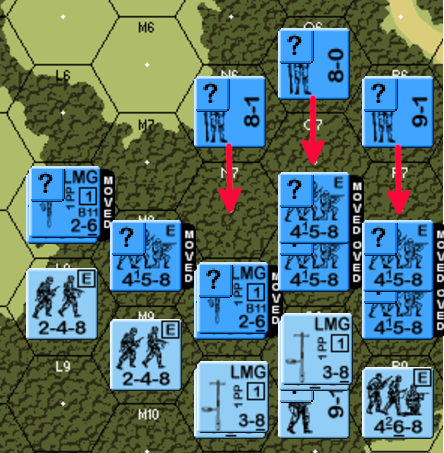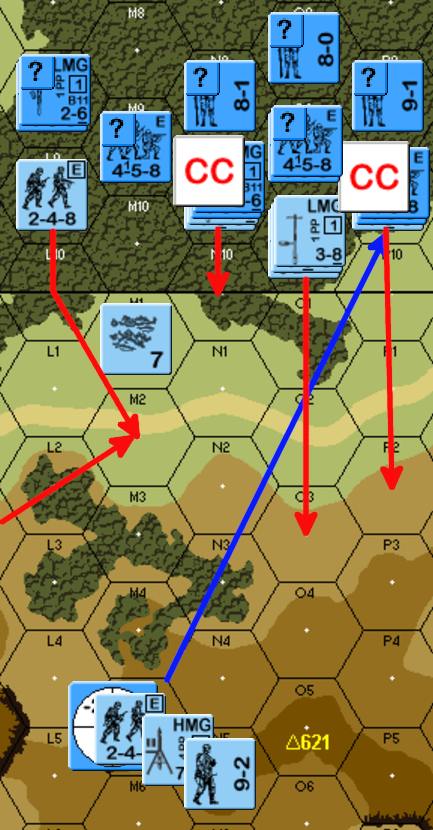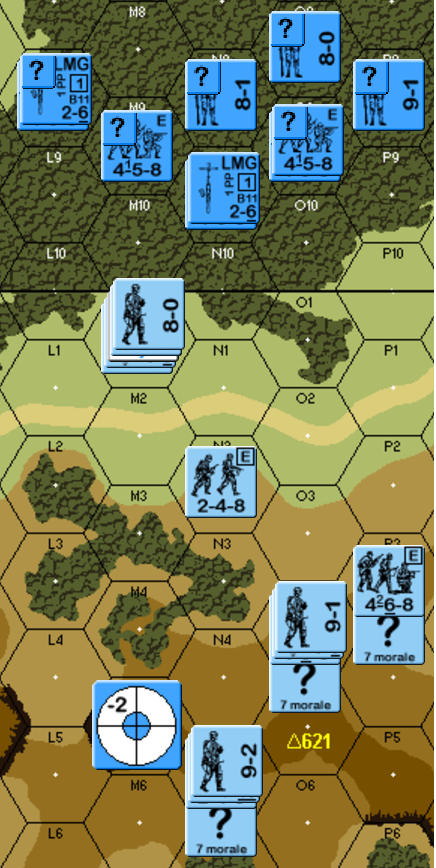This situation comes from a game I recently played. In it, I am playing the Germans and I blundered my MPh, leaving myself open to destruction. Fortunately for me, my opponent left me an opening and I was able to mostly extricate myself from the position relatively intact. Below I examine the situation, mistakes I believe each side makes, and the final position after the two Player turns.
Opening Moves

Figure 1 shows the position at the start of the French MPh. I am playing the Germans. All German units are concealed but shown here unconcealed. Also note, I have no idea what units are where when actually playing the game. The French units shown here represent things I learned later and supposition on my part.
To open the turn, the red arrows depict the French Movement. All moves are Assault Moves, retaining French concealment. One unit from O7 drops his concealment and Non-Assault Moves into O8. This compels me to drop some concealment to stop him from bump-scouting me. I unconcealed a 4-6-8/LMG combo for no effect but do stop him from bump scouting.
I can already see I am in deep trouble if he plays aggressively. By only falling back one hex, I have made it possible for my opponent to Assault Move Adjacent to me and retain concealment. What’s more, if he is aggressive with his SMC or any of the “second” squads he has in these hexes, he can strip my concealment. Fortunately for me, he was not aggressive with his extra squads.
Finishing the First Movement and Advancing Fire Phases

Here we come to the opening of the door. Completing his MPh, he Assault moves his leaders into position to clean up any units which break.
None of my units were bump-scouted, they remain concealed. His AFPh was ineffective due to a combination of halved firepower and TEM.
In my opinion, there was a stronger French option. Given all of his squads arrived ADJACENT and intact, why not aggressively move his leaders to strip German concealment? Concealment in O9 cannot be stripped, but P9 is begging to be bump-scouted. The same for N9. By opting to only Assault Move he allowed my German units to remain concealed. This not only affects his Advancing Fire, it plays a significant factor in the CC.
For AFPh, one unit each in O8 and P8 drop concealment and attempt to break the 4-6-8/LMG in O9. Both shots have no result.
Rout and Advance Phase

The 2-4-8 in M9 voluntary breaks and routs. It had lost concealment in AFPh and I didn’t like his chances. Every one else stands and fights. Breaking and running would have left my whole right flank shattered.
In ambush phase, I get a break winning two of them. The red arrows show my units retreating out of the Locations. In N9 and P9, my opponent attacks with only his revealed squads. I do not attack at all, hoping to simply survive and not be locked in melee. His attacks do not affect my units in N9/P9 and they remain concealed. I have managed to avoid melee. From my perspective, this turn is a disaster, but it could have been so much worse.
Preparation Fire and Movement Phase

Figure 4 represents the position at the beginning of my player turn. Somehow, I need to extricate as much as I can out of this position. Fully 40% of my order of battle is in a bad way and failure on this turn will almost surely result in my loss. I am facing difficult choices.
The 9-2 desperately wants off the -2 acquisition. I make the decision to take the risk and stay but I am not happy about it. Fortunately, the acquisition is from a BU French tank with a 37* gun. I make the calculated risk I can survive that shot.
This risk is necessary because of the unit P9. I would like to move this squad out but taking the -1 or -2 shot in P10 is not likely to work. The LMG unit O10 can easily get out, but I am not ready to lose the P9 squad if I can help it. The squad would have already voluntarily broke and routed last turn if there were any rally terrain around. Hence, the 9-2 HMG stack must shoot and hopefully break the enemy units in P9

Let’s take a moment to examine the rules. Per A7.4, “all the Personnel-units/unarmored-vehicles/Vulnerable-PRC in the same Location are considered targets of fire that does not have to specify a particular target, with the outcome of such fire affecting all those enemy (or Melee) units in the target Location …” There are other exception such as Area Target Type and OBA, but CC is not one of them. If my squad was unconcealed, it would be locked in melee. As it retained concealment, it is not and the 9-2 is now free to fire into the Location.
The 9-2 fires, scores a 1,1 on the 6 column for a Final 1 on the 6 column. A 2KIA is the result. The red arrows represent my movement. The N9 4-6-8/LMG break in N10 by a 12 flat shot.
Rout and Advance Phase
Figure 5 shows the position at the beginning of the German RtPh. The broken 4-6-8 moves into M1 where the 8-0 will hope to rally it in the RPh. The rest of the German army scales the hill and gets ready to shoot French units emerging from the wood line. The 9-2 survived the 37* shot and moves off to N5. The remaining 2-4-8 moves to N2. As the German army is out of LOS, it rolls for concealment and fortunately everything conceals up.
End Position

Figure 6 shows the position at the end of the turn. The 8-0 is concealed under the stack of the broken units. There is a 2-4-8 and a DM 4-6-8/LMG in M1. There is a good chance something will be there to take part in Defensive Fire. All units on the hill but the 2-4-8 manage to conceal. Given the extent of my blunder, I manage to extract something out of the situation. Note, I didn’t do this alone.
More aggressive play on my opponents part would have likely destroyed my whole right flank. Aggressive bump-scouting my concealed units not only gives him the ambush advantage, it ensures survivors of CC are locked in melee. Units locked in melee are not guarding the hill or stopping the French exit which is part of the VC.
We paused the game at this point so I don’t know the eventual outcome of this game, time will tell. I am in a much better position at the end than I thought I would have been in at the start of the French MPh. I almost instantly recognized my mistake and the dilemma I created for myself. Fortunately, he let me off the hook.
Conclusion
I share this example for a few reasons: to show my mistake in the hopes you can learn from it and to sear my mistake into my own mind so I don’t do it again. I also show it here to explain how more aggressive play could have severely tilted the game against me. Recognizing these opportunities–or in my case, risks–is key to winning more games. Unfortunately for me, I did not recognize the danger until I was already in its clutches. Fortunately for me, my opponent didn’t take advantage of my blunder and I was able to leverage some rules knowledge to extricate myself.
As always, I hope you find this helpful and informative. If you spot any mistakes and or errors don’t hesitate to reach out and let me know. Until next time. — jim


Nice example, thanks Jim. The snakeyes on your 6-1 shot helped of course, although the chance of RoF with the HMG made this a good shot anyway.
I’ve just recently discovered your blog, some good stuff here, thanks.
Thanks Andy. I appreciate the feedback.
This is where aggressive deploying of the French 458’s and use of the 238’s as the bump scouts would have had you in a world of hurt
Deployment. If deployment fails, use the full squad, if that fails, use the leaders one at a time and only risking the second if the first survives his scout run relatively unscathed. I recognized I was in a world of hurt.
I once read that an average chess player looks at his pieces more than his opponents where a grandmaster almost never looks at his pieces, focusing almost exclusively on his opponents. In this case, I got caught focusing on my own pieces and only woke up to the danger after it was too late.